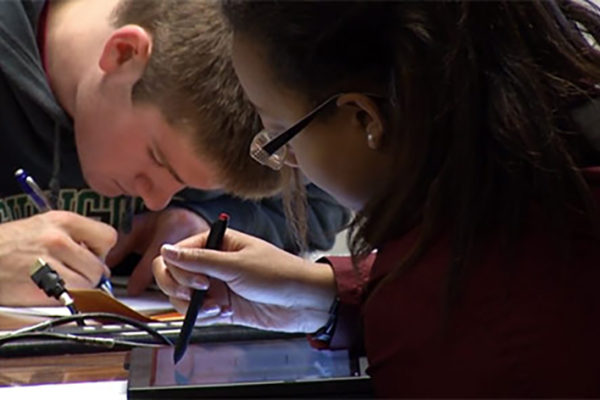WUSTL engineers provide free code to help build better batteries
Lithium-ion batteries, such as those used in electric vehicles, are in high demand, with a global market value expected to reach $33.1 billion in 2019. But their high price tags and short lives need to be addressed before they can be used in more consumer, energy and medical products. Venkat Subramanian, PhD, associate professor of energy, environmental and chemical engineering, and his team are working to solve this problem by developing optimal charging profiles for the batteries.
Wang receives honorary doctorate from Lund University
Lihong Wang, PhD, has been awarded an honorary doctorate from the Faculty of Engineering at Lund University in Sweden. Wang, the Gene K. Beare Distinguished Professor of Biomedical Engineering, has been one of the prominent figures in developing photoacoustic imaging technology in biomedicine, says Stefan Andersson-Engels, professor of atomic physics at Lund University.
Odor receptors discovered in lungs
Your nose is not the only organ in your body that can sense cigarette smoke wafting through the air. Scientists at Washington University in St. Louis have shown that your lungs have odor receptors as well. The odor receptors in your lungs are in
the membranes of flask-shaped neuroendocrine cells that dump neurotransmitters and neuropeptides when the receptors are stimulated, perhaps triggering you to cough to rid your body of the offending substance.
Cat domestication traced to Chinese farmers 5,300 years ago
Five-thousand years before it was immortalized in a British nursery rhyme, the cat that caught the rat that ate the malt was doing just fine living alongside farmers in the ancient Chinese village of Quanhucun, a forthcoming study in the Proceedings of the National Academy of Sciences has confirmed.
Washington University joins U.S.-China Clean Energy Research Center
Washington University in St. Louis has joined an international group of researchers working to make great strides in advanced coal technologies.
Staying ahead of Huntington’s disease
Huntington’s disease is a devastating, incurable disorder that results from the death of certain neurons in the brain. Rohit Pappu, PhD, and colleagues in the engineering and medical schools are conducting studies to learn from nature’s own strategies to battle the disease.
Interdisciplinary Environmental Clinic files amicus brief in U.S. Supreme Court
Students and faculty in the Interdisciplinary Environmental Clinic at Washington University School of Law in St. Louis have filed an amicus brief on behalf of air pollution scientists in an important environmental case before the U.S. Supreme Court. The case, EPA v. EME Homer City Generation LP, involves a challenge to the EPA’s Cross-State Air Pollution Rule, which seeks to protect the health of citizens of downwind states by placing limits on air pollution that crosses state lines. Electric power companies, several states and local governments challenged the rule as overreaching.
The holidays come early for WUSTL scientists
A large wooden crate was delivered to the Compton Hall loading dock last week, direct from Paris. The crate contained a fabulous new instrument that WUSTL scientists say will transform their ability to approach problems in geology, biology, space science, engineering and materials science with new precision. Called the Cameca SIMS ims7f-geo, it is a state-of-the-art secondary ion mass spectrometer, one of only three in the world.
Active-Learning Classroom blends old and new to promote student learning
The Active-Learning Classroom (ALC) opened in fall 2012 on the lower level of Eads Hall as a pilot program. The classroom is a highly flexible space that facilitates collaborative group work as well as class discussions. The pilot program was such a success, it is hoped that additional active-learning classrooms will be designed throughout the Danforth Campus.
Tyson designated an Earth Observatory
A 60-acre plot in Washington University in St. Louis’ Tyson Research Center has been named a Forest Global Earth Observatory, or ForestGEO. The oak-hickory forest in the rolling foothills of the Ozarks joins a network of 51 long-term forest study sites in 23 countries, including eight others in the United States. Together, the forests, containing roughly 8,500 species and 4.5 million individual trees, comprise the largest, systematically studied network of forest-ecology plots in the world.
Older Stories




